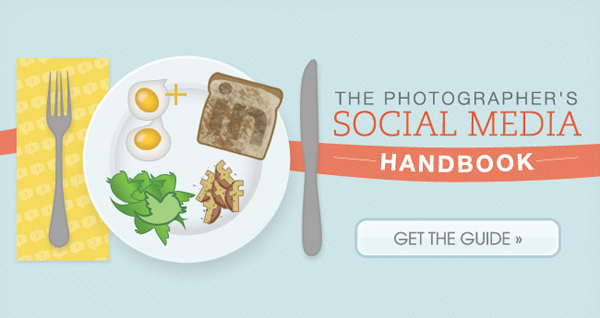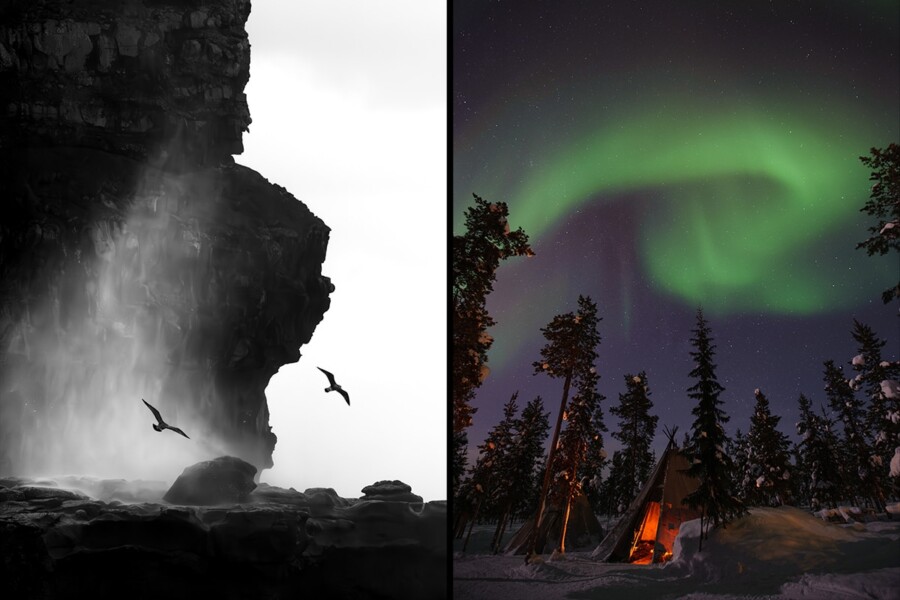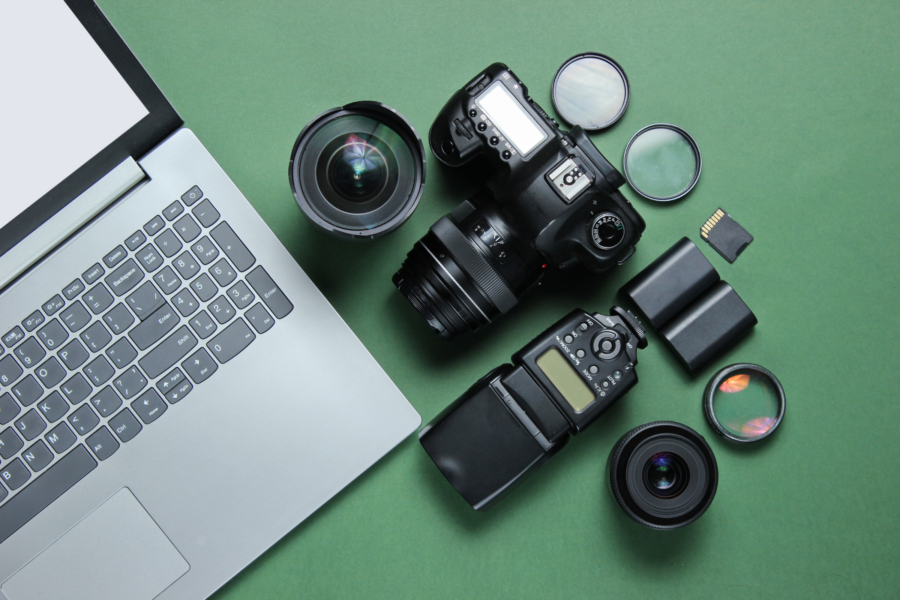Share
4 Photographers Describe Their “Social Media Workflow”
Is social media a waste of time, or are photographers actually using it to help them build their businesses and make real money? Every photographer...
Is social media a waste of time, or are photographers actually using it to help them build their businesses and make real money?
Every photographer is different. Each has his/her own unique mix of specialties, client types, marketing approaches, and workflow processes. Because everyone is different, it can be a challenge for some people to figure out if social media marketing will be a worthwhile activity for them.
Although social media is a “free” marketing activity, meaning it doesn’t require cash out of your pocket, it does require a plan, dedication, and some time and effort.
I decided to interview a 4 uniquely different photographers who are finding marketing success with social media – each in their own way. I wanted to get an idea of their overall “plan”, and the workflow that they’ve developed to help them succeed.
Todd Owyoung is a professional music photographer based in St. Louis, Missouri. His website, ishootshows.com, is a resource for music photography, featuring daily concert coverage, portrait features and photo advice.
Todd’s blog is currently showing up in the #1 spot within Google search results for the term “concert photographer”, and #8 for “music photographer.” He makes a point of using social media marketing to drive regular traffic to his site. (Follow him on Twitter @toddowyoung.)
1) When did you get started with social media? What prompted you to start factoring social media into your marketing efforts?
I started blogging about music photography in mid-2007, and I was talking with other music photographers on blogs and photo forums around the same time.
When I started my blog, I was mainly interested in a way to showcase my own work while simultaneously sharing my experiences and creating a resource for concert photographers.
2) What are the elements used in your social media strategy? Which do you feel is the most effective?
The main social media elements I use for engagement are my blog, Flickr and Twitter. For me, they act as the perfect compliment to one another.
A blog allows for rich content, while Twitter gives me a quick and light way to engage with people working in the music industry, other photographers and readers of my blog. Flickr acts as a supplemental way of putting my work in front of eyeballs and offers dialogue through their discussion groups.
3) Do you feel the effort is worthwhile? Does it pay for itself? Can you describe any sales successes directly tied to social media?
I think one of the beautiful things about social media is that it’s an organic, fresh way of presenting your work. For clients, this translates into an extension to a portfolio and photo archive.
In addition, photo buyers aren’t just looking on Getty Images or Corbis. These days, Flickr, photo posts via Google Images and more are all fair game.
The funny thing about blogging is that, short of monetization, it doesn’t pay, but there’s no mistake that it pays off. I can’t tell you how many clients I’ve talked to who said they found my blog through Google by searching for “concert photographer” or “music photographer.”
4) Who are you targeting with your social media efforts, and how do you expand your base of followers/fans?
For the most part, the people I engage with directly with social media are other music photographers and music fans – basically, people who love the rock show as much as I do.
5) Please describe your normal social media routine – from start to finish. How long does the routine typically take?
1. Shoot an assignment
2. Blog it.
3. Post images to Flickr.
4. Tweet it.
Kendrick Brinson is an Atlanta, Georgia-based photojournalist, and a member of the prestigious Luceo Images photographer cooperative. Aside from being a talented photographer, she also manages the social media marketing duties for Luceo and its 6 photographers.
1) When did you get started with social media? What prompted you to start factoring social media into your marketing efforts?
Marketing through social media has been a somewhat gradual thing for me. I was pretty active on Facebook from its start. What really clued me into how effective sharing work online could be was on Flickr, where I was pretty active from 2005 to early 2009. I learned that people–complete strangers–were interested in my work and very receptive and supportive. In these first 20 months as a freelancer, I’ve expanded my networking online very heavily and I focus primarily on blogging, Facebook and Twitter for LUCEO. Once I noticed how much traffic Facebook and Twitter could bring to LUCEO’s site, I knew it would become an integral part of our marketing.
2) What are the elements used in your social media strategy? Which do you feel is the most effective?
Blogs are completely intertwined with Facebook and Twitter in LUCEO’s social media networking. You have to have new material to post on those networking sites in order to draw in traffic. You can’t successfully market your photography without content– fresh new, always changing, always engaging content. That’s why we wanted a site that changed everyday– once you’ve seen a portfolio site, you never go back; we wanted LUCEO’s site to become a destination that you check several times a day to see what’s new.
Part of LUCEO’s mission is giving back to the photographic community so we have regular columns and blog posts that explain how a shoot went, for example, or Matt Slaby’s column that explains common legal issues for photographers. If readers know you will have a From the Archive column every Thursday, they’ll check your site every Thursday, for example. Give them reasons to come back. Our regular viewers, I think, truly enjoy watching LUCEO’s photographers’ work grow and expand and the process that goes along with that. We want our “fans” and “followers” to get to know us through our words and images. A lot of photographers don’t disclose how they got to where they are and we are an open book.
Of course we also promote other photographers’ work and photo news on Facebook and especially Twitter. I try to stay up to date by reading lots of photo blogs and following photo industry news feeds on Twitter. I want people to hear news from us first and rely on us for keeping up to date.
Again, though, no content means nothing to post on Facebook and Twitter and no hits on your blog, archive, or site. New content is crucial.
3) Do you feel the effort is worthwhile? Does it pay for itself? Can you describe any sales successes directly tied to social media?
My social media marketing efforts on the behalf of all of the LUCEO photographers is without a doubt worth it. We could potentially sell ad-space on our site if our traffic rates continue climbing as they have been. Specifically, this is just one example, I got a phone call from a photo editor at The Wall Street Journal after I wrote on Facebook that I was doing a shoot in Alabama for a client. That editor wanted someone in Alabama and passed the job on to me. If he hadn’t seen that in his Facebook livefeed, he would have given the job to a local photographer. Right there, social networking put money in my pocket. This happens often.
4) Who are you targeting with your social media efforts, and how to you expand your base of followers/fans?
We specifically target photographers. I think our blogs and portfolios appeal to both students and professionals alike because we have such a talented group of diverse photographers.
I think our base expands through word of mouth because there is so much new content weekly. We started with friends and clients and it keeps growing from there. If you provide helpful, interesting, engaging content readers will keep coming back for more.
5) Please describe your normal social media routine – from start to finish. How long does the routine typically take?
I often have 1-4 blog posts to publish from myself and the other LUCEO photographers each day. I make a point of staggering when they go live throughout the day. I tend to keep the window for that between 9 am EST and 7 pm because this is a job and I want to keep sane and I think most of our traffic comes during those times when people might be bored at work or looking for some inspiration or catching up. So I’ll publish a blog post, then I’ll post it on LUCEO’s Facebook fan page, which I try to make sound intriguing–by pulling a quote or talking about an interesting photo or event that the blog post covers.
I always tag the person who wrote the blog post so it appears on their Facebook wall and gains the eyes of their friends. I then post something similar on LUCEO’s Twitter account at a different point in the day. Once something is published on Twitter, Matt Slaby and I both retweet that on our own accounts because we both have different followers than LUCEO’s account has. This is repeated throughout the day.
I think publishing multiple posts on a blog at once is a waste of content and that staggering the posts brings in more eyes.
(By the way, yes I realize LUCEO has more content than a lone photographer because we are six photographers. Push yourself to have a regular something that runs every Wednesday, for example, an archive photo, or a how you lit an old shoot guide. Make your viewers bookmark your site to come back to regularly. The more eyes on your site, the more odds of getting work.
Sometimes I will post quotes from photographers and ask questions that pertain to news or photography. We’re interested in having a dialogue with people who follow our work. I think social networking is still about relationships and it is important to respond to comments and discussions. You can’t barage people with content and never comment on theirs because no one wants to be a part of a one-sided relationship.
This is a lot of work, don’t get me wrong. I spend several hours a week doing social media marketing. Anyone who knows me knows I’m on my iPhone a lot. A whole lot. I’ll retweet photo news on my phone from a line at the grocery store. Yes, I’m that annoying person, unfortunately. But! It works! Facebook and Twitter are both free marketing tools that should not be ignored. Not only do they create buzz with our peers, but also with the people who hire us.
LUCEO also has a Tumblr account, by the way, though it isn’t updated as regularly as Facebook or Twitter.
Craig Holmes is a professional photographer who runs Images of Birmingham, the largest supplier of professional stock photography relating to Birmingham, UK, and its surrounding areas.
Craig uses Twitter to send efficient, high quality targeted traffic to his website, and generate increased awareness of his brand.
1) When did you get started with social media? What prompted you to start factoring social media into your marketing efforts?
I started using Twitter about 18 months ago at the recommendation of a friend who works in marketing. He suggested I could target my market using the service. I did have a lot of doubts, but gave it a go. The original intention was to use it to create an awareness for the brand, and our images.
2) What are the elements used in your social media strategy? Which do you feel is the most effective?
We only use Twitter (@ImagesofBrum). Although we have trialed blogs, Facebook and LinkedIn. Facebook was aimed too much at the general public, and they only account for a small percentage of our sales, so time spent marketing to this segment, could be better used elsewhere. Blogs, we found, demanded too much work from the viewer. LinkedIn has potential, and is worth watching, although at the moment we feel our marketing efforts are, again, better spent elsewhere.
Twitter, on the other hand, ticks all the boxes. We can follow, and be followed by, the Small to Medium Enterprises (SME’s) that make up much of our customer base (we would follow our larger corporate customers, but often find their accounts are managed by ‘someone in customer service’), it requires little effort by the viewer, and generates a lot of traffic for our site.
3) Do you feel the effort is worthwhile? Does it pay for itself? Can you describe any sales successes directly tied to social media?
Awareness of our brand has definitely increased in the 18 months we have used Twitter. I spend a lot of time with people who work in marketing, and can confirm that many more people know of the site, and can even repeat the web address from the top of their head. Awareness may only be the first stage in the decision to purchase, but it is an absolutely key one.
Google Analytics also shows that Twitter passes a lot of clients my way, both old established ones, and potential new ones.
As an example of a direct sale, we mentioned on Twitter that we are now able to offer panoramic prints for sale. That very day, we sold two images to new clients who had seen the tweet. Without building the awareness of the brand in the first place, clients may not feel confident to buy from an unknown source. These sales are extra to those of existing clients, so provide extra revenue streams.
4) Who are you targeting with your social media efforts, and how to you expand your base of followers/fans?
We aim at the Small to Medium size Enterprises (SME’s), e.g. marketing and advertising agencies, as well as organisations that tweet about Birmingham as a whole (e.g. tourism bodies, magazines). The growth has been organic. We don’t go out and follow lots of people, rather we wait for them to see others retweeting our messages, and they then follow us. It has a lot more ‘honesty’ using this method. People get sick of being followed by completely random organisations, so we let them come to us. Saying that, we do mention our Twitter name at any opportunity.
To a certain extent, we rely on others retweeting our messages. I know there are certain followers who will retweet a message on a regular basis. This means a message can be seen by several thousand people in a very short space of time, for free. Similarly, we then get followers who mention us on blogs for various reasons e.g. they like the images, they like the business model etc etc.
5) Please describe your normal social media routine – from start to finish. How long does the routine typically take?
Each day we try to post a new ‘photo of the day’. This takes two minutes at most. Apart from that, we offer occasional discounts, and sometimes mention other stories. We don’t bombard people, and we rarely repost tweets (if people think they can look later, they rarely do!).
Essentially:
1. We add images to the library on PhotoShelter, or note specific events (e.g. Christmas, celebrations etc), or we watch the news for Birmingham (we keep an iPad running on the desk with latest news for Birmingham streaming in). Based on this we choose one image for photo of the day (for example, when Jaguar Cars confirmed they would not be closing the Birmingham factory, we chose an image of the production line).
2. We post the chosen image on Twitter, as a link back to our library.
3. We compare images we have chosen to sales made, if there is no match, we choose other topics for photo of the day (using the example of Jaguar above, an existing trusted client downloaded the Jaguar image for publication the next day).
Social Media is definitely just one part of our marketing mix, many other factors come in to play e.g. magazine advertising, SEO etc. However, comparing the various costs of marketing, there is little to beat social media when it comes to getting people to view our site. Do a percentage of those viewers buy? Yes they do.
Andrea Wilson is a motorsports photographer based in Huntington Beach, California. She specializes in shooting commercial and editorial motorcycle racing, as well as personal watercraft.
She uses her Facebook and Twitter social networks as a cost-effective way to drive traffic to her blog and photo archive, and improve her SEO.
1) When did you get started with social media? What prompted you to start factoring social media into your marketing efforts?
I had a Facebook account for a few years because my little sisters talked me into it, but I didn’t see the marketing potential until early 2009. That’s mainly because my marketing efforts before then, sadly were pretty much nonexistent. At the time, there was a pretty large community of the motorcycle industry that was continuing to grow each day on Facebook. I started to see the opportunity, and looked at it as a side project for my downtime and ultimately it worked out quite well.
2) What are the elements used in your social media strategy? Which do you feel is the most effective?
I use mostly Facebook and Twitter to direct attention to my Blog and PhotoShelter Archive. I have a LinkedIn account, but don’t use it that much for the time being because I have my hands full with the other two. For me, I find Facebook and twitter most effective because that is where my audience is concentrated at the moment. And between those 2, Facebook has been more effective because I have been on there longer and have put more time into building my network there.
3) Do you feel the effort is worthwhile? Does it pay for itself? Can you describe any sales successes directly tied to social media?
Yes, for two reasons. The internet is truly global. Social media is a cost effective way to for me to extend my sphere of influence by having a platform to display my work and network with potential clients. Up until mid 2009, most of my client base has been in the US. With social media, I have been able to expand that internationally without having to book a plane ticket.
It has also helped me reach a wider audience in my industry in the states. A real eye opener for me a few years ago was hearing on more than one occasion from a potential client that they had not seen my work. Now, I have people coming up to me saying, hey I really like your work or I liked your photos from such and such event. The exposure I’ve received through Facebook has added more editorial and OEM clients to my list.
The second reason I feel the effort is worthwhile, SEO. If you build a social media audience, you can direct them to your blog or website to help your SEO efforts. Social media efforts grow exponentially. The more you put into it the more you get out of it. So combining a Social Media campaign with Analytics can go a long way in your efforts to boost SEO. Before I started using social media as a marketing tool, my hits were really low, just my contract clients. After a few months time I noticed an increase. After a year they doubled and another six months after that, they have doubled again.
4) Who are you targeting with your social media efforts, and how to you expand your base of followers/fans?
I target the Motorcycle Industry and enthusiasts alike. And I expand my followers/ fans through engaging content. I post links for Photos of the Day, take an occasional vote for desktop photos, and post slideshows of my favorite work from a recent event. With the help of analytics (and ok, sometimes common sense), I focus content on popular appeal. I may have a beautiful shot of a certain rider, but it has a significantly less hit count compared to one of a superstar.
Also, what I feel is important, I focus more on social and less on sales pitch. Think of it like being at a coffee shop or a bar. Do you want to engage in a conversation with someone who only talks about themselves and/or what they are selling? It’s just as important to participate in the social atmosphere as well as get your message across to your audience. That doesn’t mean you can’t throw a sales pitch out, it just means make sure you are having a two-way conversation.
5) Please describe your normal social media routine – from start to finish. How long does the routine typically take?
I don’t really have a specific routine. At the beginning of the week, I come up with a plan for content for the week and trickle it out over the course of that week. I try to spend an hour a day posting, responding to posts, and being basically a cyber social butterfly. I generally take most of the weekends off, and if I’m busy, the hour a day drops off but I make up for it during the downtime.
It’s not that difficult to integrate keeping up with your social networks into your daily routine, especially in the age of smartphones. Post some content in the AM. Check up on it before lunch. Post that content on another network after lunch. And then check up on it before the end of the day. You can do this from your office or even while you’re waiting in line for a mocha latte whatever.
______________________________________________________________________
For more info to help grow your photography business online, check out PhotoShelter’s recent two-part free guide, The Photographer’s Social Media Handbook.








